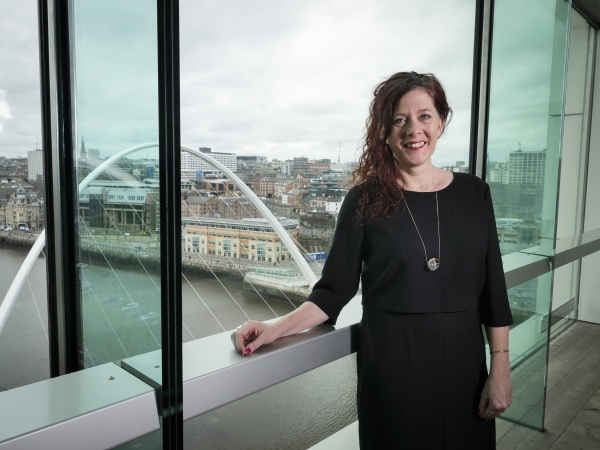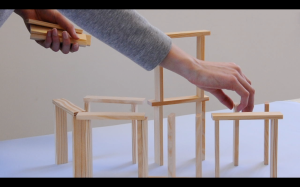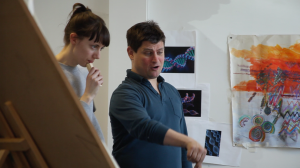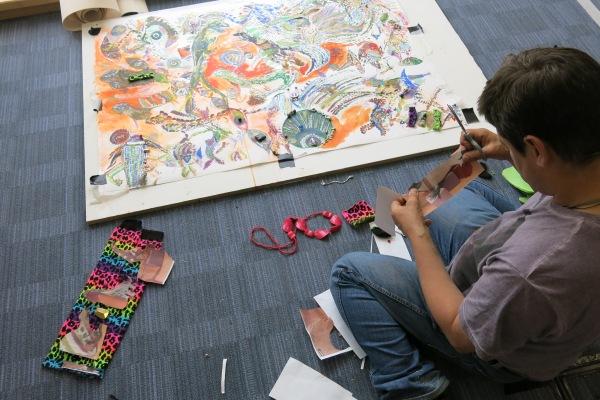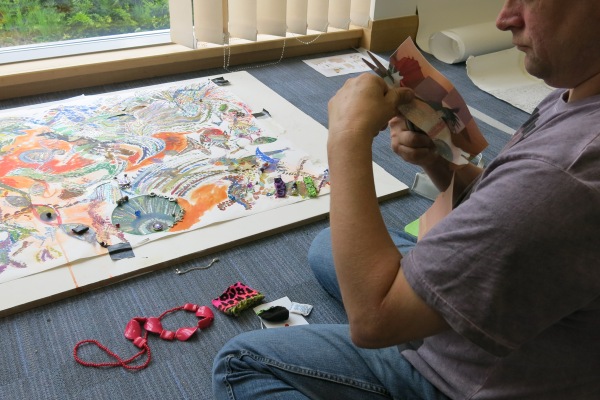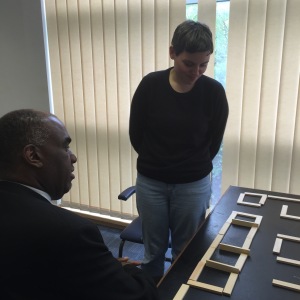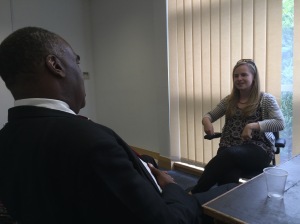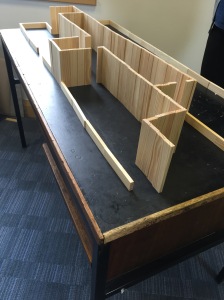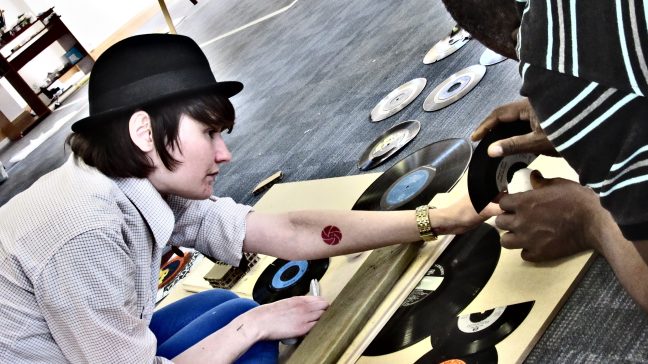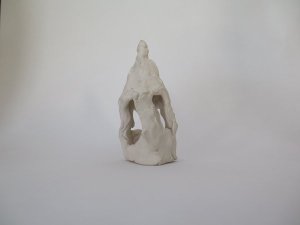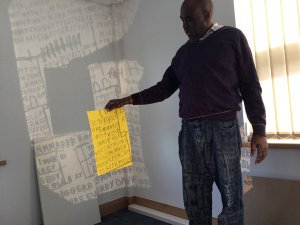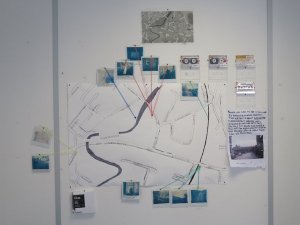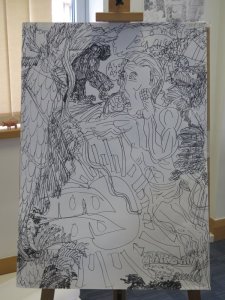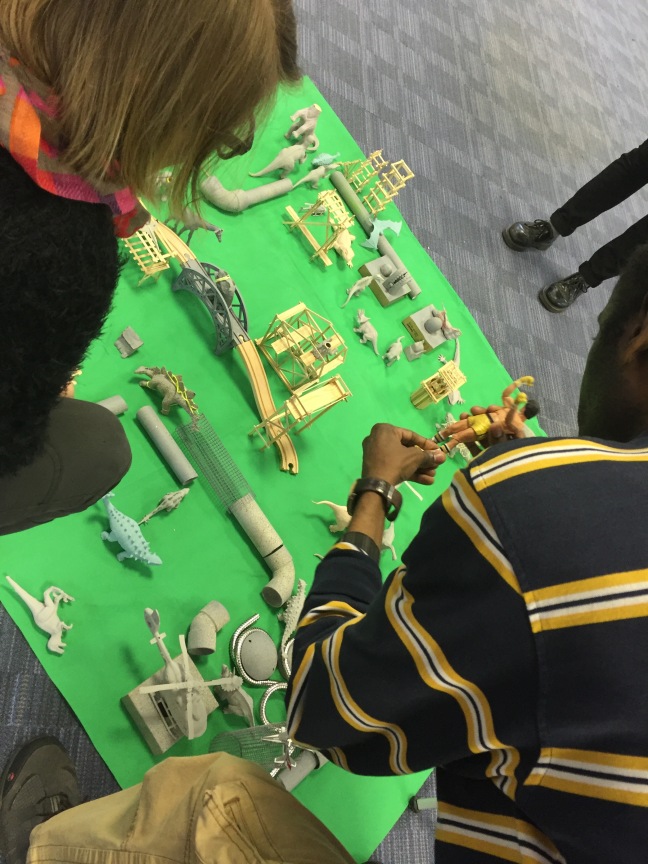We sat down with Juliet Davis to ask her about her thoughts and experiences on the OutsiderXchangeS project. Exploring how it may have changed her work and how she collaborates.
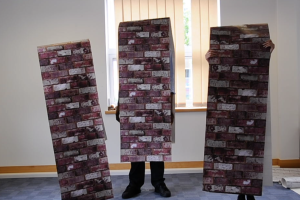
How did you approach collaboration within the project and what difficulties did you discover, how did you overcome them and also what successes have you discovered in collaboration?
Collaboration, whatever the level, is a very important part of my work; I rarely do art projects on my own. I don’t really have a studio based practice so that was a first “challenge” for me, finding ways to make my thought processes and experiments visible in the space and intriguing enough for people to get interested in them.
I spent most of the first few sessions wandering around the space, chatting to people, looking at what they were doing… but not really creating work at my desk. I noticed that most of the Venture Arts artists were really focused on their work, getting on with it from start to finish, Barry even eating his lunch at his desk!
I wasn’t sure how to approach them as usually I will collaborate with people with specific projects in mind, everybody’s role and position in the group being quite clear, this time there wasn’t necessarily a clear entry point for the discussion and I was pressuring myself about having to create work with absolutely everybody.
I think the collaboration with Sophie and Horace started quite naturally, Sophie and I had a chat outside of the studio space, and then visiting Horace’s school with Martin really helped bounding us. After that Horace was always really up for trying new things we would propose, always bouncing off his own work. The ‘unproductive’ time spent with Horace looking for people or places on our laptops also really helped getting used to his sensibility!
So I think I’ve learned to value the time spent together in a studio setting without a specific outcome in mind (which I hadn’t really had since finishing my master 2 years ago).
I will usually do lots of research and thinking before acting (but not necessarily change things several times), this time because of the long duration of the residency, I really had time to build up ideas, then realise what parts actually interested me, repeat this several times, but also try things out without really thinking about it much before doing it (like the ‘if you could invite anybody in the world to our party, who would that be?’ question which in less than 10 led me to start building life-size cardboard models of people’s favourite guests.

Will the way you work in collaboration change now moving forward – was there a particular way you approached collaboration before?
I used to collaborate with people I either knew very well and/or whose work I knew well, people who’d been to art school too and had very similar interests and references to mine, but often from different perspectives (sound, drawing, graphic design, film making, dance…). And as my work has a site specific/contextual approach to the environment, we would always have a very clear outcome/setting (an exhibition space, a certain event…). This time it was with people who have a very different approach to art than I do (and also people who had similar art education as me), and we were not sure about the form of the final showing.
It’s made me realise the importance of just trying things out before setting ideas and giving time for relations and ideas to evolve.
I realised that there were lots of ways to ‘collaborate’. I think I was quite weary of ‘using’ Venture Arts artists’ practices to create something that wouldn’t be meaningful to them, but by leaving things open ended and not feeing rushed some exchanges happened (even if it was just a discussion, giving someone a hand… and not necessarily creating a work together with absolutely similar involvements).

How has the OutsiderXchangeS project changed your artwork?
My work is usually immaterial or takes the form of performances. This time, because all the other Venture Arts artist create works with visual physical outcomes, it helped me think of my work as installations, actions to be documented in video, etc.
But all the participants have a very ‘performative’ element in their art making, for example Barry whose writings are almost like performance writings; it’s helped me think of ‘performativity’ in a more open way. The discussions we had about celebrities, actors and TV shows has really made me think about ‘reality’ and ‘fiction’, when do both start and end… how important they are to us.
As an artist and person, I think I’ve become more patient and comfortable about speaking to people I don’t know. I feel like I have more attention and understanding for people I come across in public spaces. Disturbing/highlighting social behaviours and conventions was already very important in my work but it’s like these six months have really help put my beliefs into practice, so I hope this evolution will transpire through my future works and ways of working.
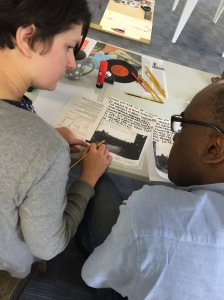
How has it been working with artists who have a learning disability? Is there a difference? If so what is that?
They have very different artistic or cultural references to me (having been to art school, so being quite knowledgeable of art history and always ‘aware’ of it when I work, and also being foreign – so knowing little to nothing about British TV series or movies.). This meant that when we were interacting I couldn’t focus on the things I usually focus on.
I think there are common elements in the reasons why we do art and why we enjoy it, but also great differences, due to the fact we experience the world in very different but also very similar ways. We share really strong feelings in common (for example our admiration for a movie or a character) but they will take different places in our lives.
It really made me more aware of the direct impact that engaging with art / creating art can have on people’s wellbeing, why it’s important for people like Horace or Sarah or Leslie to do art, and how I can contribute to that.
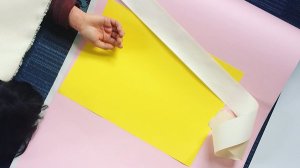
If there was one thing you felt proud the most about the OutsiderXchangeS project what is that? – This could be a piece of work, a collaboration, the environment…
I was really amazed by how the geography of the studio evolved throughout the months, at first we were all in our own corners and Matt’s decision to invest the centre of the space felt like a really bold statement, now everything is much more fluid and we feel comfortable working next to someone / don’t feel like we’re being intrusive. I feel like we’ve all created a really welcoming atmosphere in the group and that James, Martin, Glen and Tanya’s presence and advices throughout the months have really helped make everyone feel comfortable.
Then there are those little pearls that happened, which were not exactly ‘art making’ but really bonding moments: that day Leslie hugged Sophie to say goodbye, that day Sarah got really interested in the book I’d brought for Leslie weeks before (which didn’t really interest him) and we spend over 30min reading it, the day Horace took us to see his old school and wait for a freight train – and the level of excitement when a train did actually go past! I feel like these were moments when we forgot about our differences or what was expected from us and just enjoyed that sharing of joy.


